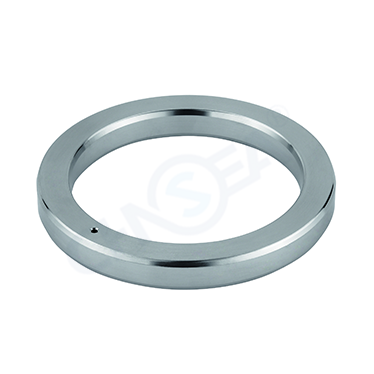The failure of octagonal gasket installation needs to be analyzed in combination with several key reasons. The common faults are ranked as follows:

1.Dimension conflict (accounting for 60% of the failure rate)
- Ring number model error: R23/R34/R45 and other models do not match the flange trapezoidal groove. The ring number should be checked against the HG/T 20633 standard.
- Cross section inclination deviation: standard inclination 23° (actual measurement>25° means it cannot be embedded). Use a projector to detect the inclination, and return to the factory if it exceeds the tolerance.
- Excessive outer diameter: The flange groove width should be 0.3-0.5mm larger than the outer diameter of the gasket. Use a micrometer to measure the difference between the groove width and the outer diameter of the gasket.
2.Sealing surface hard defects (accounting for 25% of the failure rate)
- Flange trapezoidal groove damage: radial scratch depth>0.1mm will cause leakage, and forced installation will crush the gasket! Use oilstone to grind to Ra≤3.2μm.
- Octagonal gasket edge defect: collision causes local deformation > 0.2mm, and resistance increases sharply when inserted. The defect should be smoothed with a fine file, and grinding of the sealing bevel is prohibited!
3.Alignment deviation trap (accounting for 10% of the failure rate)
- Flange parallelism error: The gap difference between the two flanges is > 1mm (when the pipe diameter is ≤ 300mm), and the bolt preload is unbalanced. The bolts should be loosened and recalibrated, and the adjustment gasket should be added if necessary.
- Bolt hole misalignment: The amount of misalignment is > 5% of the bolt diameter so that the bolt cannot be inserted freely. It is strictly forbidden to expand the hole or violently penetrate the bolt, which will damage the thread.
4.Cleanliness is out of control (accounting for 4% of the failure rate)
- Welding slag/metal chips: stuck at the bottom of the groove, causing the gasket to be unable to fall into place. Use compressed air + copper wire brush to clean.
- Wrapped graphite tape: incorrect operation causes the gasket to thicken (it is strictly forbidden to add any filler). Graphite residue should be completely removed.
- Anti-rust oil residue: reduce the friction coefficient → the gasket slips and shifts during installation. Use acetone to clean the sealing surface.
5.Installation operation error (accounting for 1% of the failure rate)
- Violent hammering of the gasket: causes plastic deformation of the octagonal gasket, resulting in failure of the sealing belt. Use hand pressure to allow the bolts to be loaded gradually.
- Wrong pre-tightening sequence: Failure to tighten in a cross-cross sequence causes the flange to deflect and jam the gasket. The torque should be loaded three times (30%/60%/100%).
- Share the ultimate self-check method. Before installation, put the octagonal gasket into the trapezoidal groove and rotate it 45°. The contact line must be connected without interruption. Then use a feeler gauge to check the gap between the gasket and the bottom of the groove. ≤0.05mm is qualified.
The above content is an industry science popularization sharing.
About us
As a senior enterprise in the industry, Wenzhou Huahai Sealing Co., Ltd. also focuses on the production of elliptical gaskets. The company has passed the ISO9001 international quality management system certification, the American Petroleum Institute API – 6A and API17D certifications, and also has a special equipment production license. This is an authoritative recognition of our product quality and production standards. Whether your project is facing challenges of high temperature, high pressure or strong corrosion, we can accurately match the most suitable materials for you.
Declaration: The above contents and data are from public network data. If any errors are found, please contact us.
